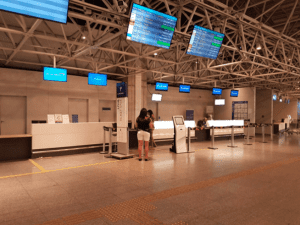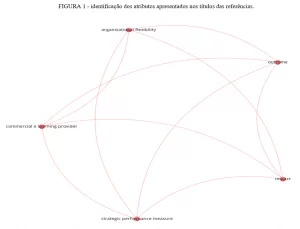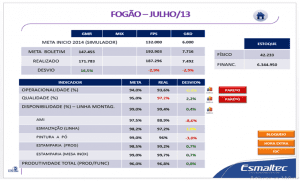ORIGINAL ARTICLE
PISSARDINI, Paulo Eduardo [1], ALVES, Kayke Hernandes [2]
PISSARDINI, Paulo Eduardo. ALVES, Kayke Hernandes. Smart industrial products’ role in industry 4.0: from a strategic paradigm of manufacturing management towards new holonic manufacturing system. Revista Científica Multidisciplinar Núcleo do Conhecimento. Year. 08, Ed. 11, Vol. 01, pp. 112-128. November 2023. ISSN: 2448-0959, Access link: https://www.nucleodoconhecimento.com.br/production-engineering/smart-industrial-products, DOI: 10.32749/nucleodoconhecimento.com.br/production-engineering/smart-industrial-products
ABSTRACT
The advancement of technology and the advent of the fourth industrial revolution have significantly influenced manufacturers’ strategies when it comes to production. In parallel with practical development, terminology may need to be changed over time as new information/technology or when understanding a particular concept evolves. This allows the language to reflect the current understanding and knowledge and ensures that communication remains accurate and precise. This study uses a systematic literature review together with theoretical-conceptual research to compare Industry 4.0 and Holonic Manufacturing System features. The results presented a theoretical-deduction framework illustrating where Industry 4.0 becomes New Holonic Manufacturing System. This work contributes to theory, motivating researchers of both fields to move efforts to jointly achieve New HMS. In practice, the proposed framework gives managers a deep understanding of the pathway organisations should follow to achieve a New Holonic Manufacturing System. Finally, it was possible to conclude that in the limit of full adoption, industry 4.0 becomes a New Holonic Manufacturing System.
Keywords: Industry 4.0, Holonic Manufacturing System, Smart Industrial Products.
1. INTRODUCTION
The advancement of technology and the advent of the fourth industrial revolution have significantly influenced manufacturers’ strategies when it comes to production. With the advent of new technologies, organisations have been able to adapt to changing market trends and consumer demands. In recent years, we have seen the emergence of disruptive technologies that have fundamentally transformed manufacturing processes. These technologies have led to the emergence of data-driven manufacturing, a new era in which machinery is equipped with advanced technologies to gather and analyse data, improving efficiency and effectiveness.
Since the first industrial revolution, some manufacturing management approaches have been developed in operations to maintain a high competitiveness level for organisations. Changes in marketing profile as well as political contexts were the fuse for other manufacturing approaches and Strategic Paradigms of Manufacturing Management (SPMM), such as Lean Manufacturing, Responsive Manufacturing, Agile Manufacturing, Mass Customization Godinho Filho (2004) and, Industry 4.0 Pissardini; Sacomano (2019a), each one guided by a marketing objective as cost, quality, high response, agility between others.
Factors such as the dynamicity of the marketing, smaller batch-size necessities, and growing orders for customised products are making traditional manufacturing systems obsolete FRANCO; BATOCCHÍO, 1999). The Holonic Manufacturing System (HMS) concept, which emerged at the beginning of the 1990s, aims in the long term to develop flexible adaptative systems for manufacturing, equivalent to the “plug and play” technologies from new computational systems. This generation of manufacturing systems will form distributed, reconfigurable, virtual factories in which men, machines and computers will compose dynamic blocks (HMS, 1999). Although this field of research was consolidated, Industry 4.0’s disruptive technologies bring new possibilities to achieve holonic manufacturing with new features compared to the traditional HMS proposals.
Even with these motivations to accomplish this study, achieving terminological consensus (main objective of this research) in operations management brings advantages such as clarity and consistency, facilitation of cross-disciplinary research, advancement of the field of study and improved decision-making.
Considering these evolutions, this investigation suggests the following research questions:
a) how do SIPs fit the Industry 4.0 Functional Architecture?
b) which barriers and capabilities are faced to allow Industry 4.0 to become a New HMS?
c) what is the role of Smart Industrial Products (SIPs) in allowing the evolution of Industry 4.0 from a PEGEM toward a New HMS?
d) at which moment Industry 4.0 becomes a New HMS?
To answer the mentioned questions, this study presents a theoretical, conceptual analysis to identify the role of Smart Industrial Products in evaluating Industry 4.0 from a single SPMM toward a New HMS. This paper is organised in structured sections as follows: Section 2 offers a brief theoretical background, Section 3 describes the research methods, Section 4 presents the results, Section 5 presents the discussion and Section 6 concludes the paper with future study suggestions.
2. THEORETICAL BACKGROUND
In this section, we discuss the main constructs addressed in this research. First of all, we conceptualise HMS in the light of the main researchers in the field. In sequence, SPMM, Industry 4.0 and SIP are then conceptualised.
This conceptualisation provides theoretical subsidies to further discuss the evolutional path for organisational functions in the industry 4.0 environment toward a new holonic manufacturing system.
2.1 HOLONIC MANUFACTURING SYSTEM, SPMM, INDUSTRY 4.0 AND SIPS, AN INTEGRATED APPROACH
The field of holonic manufacturing was initiated in the early 1990s to address the upcoming challenges of the 21st century (Mcfarlane; Bussmann, 2010). To define HMS, it makes important to define holon. According to Christensen (1994) “holon is an autonomous and cooperative building block of a manufacturing system for transforming, transporting, and storing physical and information objects”. This way, as stated by Mcfarlane; Bussmann (2010), “it consists of a control part and an optional physical processing part”. Thus, according to this definition, a Smart Industrial Product is conceptualised by Pissardini; Callefi; Godinho Filho (2021) as “products containing elements of the physical, connected, and smart dimensions, responsible for integrating physical and digital parts. These products should have embedded systems that allow smartness to recognise, analyse, and autonomously exchange data regarding the customer, the goods being produced, the process, and the environment in an integrated and real-time way. Further, SIPs should offer innovative integrated services through the self-improvement of its configuration to provide the best possible performance and maximise value for the organisation”, can be considered as a system of holons. “Yet, a System of holons cooperating to achieve a final objective in a given environment is then named holarchy” (Christensen, 1994).
Besides, Godinho Filho (2004) defines SPMM as “strategic and integrated management models/patterns, aimed at certain market situations, which are intended to help companies achieve certain performance objective(s); These paradigms are composed of a series of principles and enablers that allow companies, based on its manufacturing function, to achieve such objectives, increasing its competitive power”. From this definition, it is possible to perceive that a SPMM is configured to achieve specific markets, making it difficult to constantly answer changes in demand standards. If on the one hand, the growth in complexities brought some challenges for manufacturing management; on the other hand, disruptive technologies brought another era to Manufacturing, allowing managers to deal with these complexities through the called industry 4.0, defined by Kagermann; Wahlster; Helbig (2013) as “[…] technical integration of CPS into manufacturing and logistics and the use of the Internet of Things and Services in industrial processes”. This will have an impact on value generation, business structures, downstream services, and workforce organisation. Besides, Industry 4.0 is transforming the way companies conceive, produce, enhance, and distribute their products (IBM, [s.d.]). Companies are adopting cutting-edge technologies, including the Internet of Things (IoT), cloud computing, analytics, as well as Artificial Intelligence (AI) and machine learning, to enhance their production facilities and operations. Some of these technologies are part of what we call Smart Industrial Products. The following section presents the research methodology to meet the proposed objective.
3. RESEARCH METHODOLOGY
This section details the steps followed to meet the research objective. It used some data raised in previous studies to support our research hypothesis, presenting a conceptual deduction framework with the evolutional path of Industry 4.0 from a static SPMM to an HMS.
3.1 THEORETICAL CONCEPTUAL RESEARCH
This research is theoretical-conceptual, and the steps followed to meet the research objective, answering each proposed research question are presented in the following sections. According to Meredith (1993), using conceptual research methods based on descriptive, empirical investigation can significantly increase the external validity of Operations Management research conclusions and, thus, their corresponding relevance to managers. Therefore, a conceptual model with or without propositions represents or describes (but not explains) an event, object or process (Lin, 1976).
Three conceptual frameworks exist in theoretical-conceptual research: conceptual induction, conceptual deduction, and conceptual systems. This work presents a conceptual deduction framework, defined by Meredith (1993) as a postulated framework with ramifications/predictions detailed for comparison with reality. Even with these features, a conceptual deduction framework helps managers better understand the dynamicity and simultaneous real-time interaction among variables that comprise complex environments.
3.2 RELATIONSHIP BETWEEN INDUSTRY 4.0’S FUNCTIONAL ARCHITECTURE AND SIPS
In the first moment, we present the functional architecture and, in the following, the framework proposed by Pissardini et al. (2022) to operationalise an SFC 4.0. This framework illustrates the informational flow for data collected from RFID towards the digital twin technology and its consecutive feedback, improving the entire operating system in a closed loop.
In the presented framework, the SIP is the primary source of data collection. These data enter into the closed loop system through RFID tags, also used as Industry 4.0 Ordering Coordination System (OCS), considered an individual entity (holon) by researchers in the HMS field of study (Brussel et al., 1998; Brussel et al. 1999; Cardin et al., [s.d.]; Mcfarlane; Bussmann, 2010). Section 4.2 presents a framework for the relationship between them.
3.3 SIPS: CAPABILITIES ACQUIRED, BARRIERS FACED, AND SIP’S ROLE IN ENHANCING ORGANISATIONAL FUNCTIONS’ SMARTNESS
In a second moment, capabilities provided for operations was proposed by Pissardini; Callefi; Godinho Filho (2021) as and barriers faced in implementing a SIP were raised through a systematic literature review, consecutively benefits and challenges in achieving Industry 4.0. The three autonomy levels were adapted from Oluyisola; Sgarbossa; Strandhagen (2020), and the capabilities and barriers were classified through semantical similarity performed with the help of the Software NVivo 13.
Level 0 (Traditional) is any paradigm under which a given organisation works. Level 1 (Connected) is the lowest level of Industry 4.0’s adoption. In sequence, level 2 (Transparent) is achieved when the processes are connected and integrated. Finally, level 3 (Autonomous Decision-Making level is achieved when the processes are connected, integrated and an organisation surpasses all the barriers related to the previous levels).
Capabilities were first grouped according to the organisational function they impact and, after that, into three categories, considering the autonomy level provided by a SIP for organisational functions. The same process was done for barriers. The summary of the capabilities, barriers, and levels impacted is presented in section 4.2.
3.4 INDUSTRY 4.0: FROM SPMM THROUGH A NEW HMS
In the last moment of our research, we compared the features of HMS and New HMS, proposing a conceptual deduction framework to illustrate the relationship between capabilities, barriers, the organisation’s autonomy level in terms of Industry 4.0 deployment and the proximity level of the New HMS, also presenting in the model, the enables that allow organisations, through its SIPs, surpass each level toward the next.
4. RESULTS
This section presents the results of this research in the form of answers to the research questions raised in the section introduction whose step to step were detailed in sections 3.2 to 3.4.
4.1 HOW DO SIPS FIT THE INDUSTRY 4.0 FUNCTIONAL ARCHITECTURE?
Functional Architecture (Figure 1) was proposed by Pissardini; Sacomano (2019b) to make Production Planning and Control in Industry 4.0 functional. The proposed framework presented the elements that should compose Industry 4.0 SPMM. Having RFID not only as OCS but also as an individual entity (holon), these tags collect and export data from an infinity of variables on the shop floor, being the most basic level of data gathering to support Industry 4.0. Figure 2 presents the structural relationship between 4.0 SPMM, SIPs, and RFID. In an HMS vision, the SPMM (macro) level is the Industry 4.0 paradigm, with all the elements that compose four pillars: Drivers, Enablers, Market Objectives and Principles. Regarding the SIP’s (meso) level, we can see an holarchy working. However, this holarchy has three different levels, according to the capabilities SIPs provide for the operations and the group of barriers organisations can surpass. We can see a single entity working at the RFID (micro) level. This entity may be a sensor, a RFID tag or another single element connected as part of the entire system.
The meso level of the framework presented can provide different capabilities for organisational functions according to the autonomy level of maturity and “enablers” present in the organisational process. The following section will show the capabilities, the barriers, and the level impacted by these capabilities and barriers.
Fig. 1. Relationship between Industry 4.0 (SPMM), SIPs (Holarchy) and RFID (Holon)
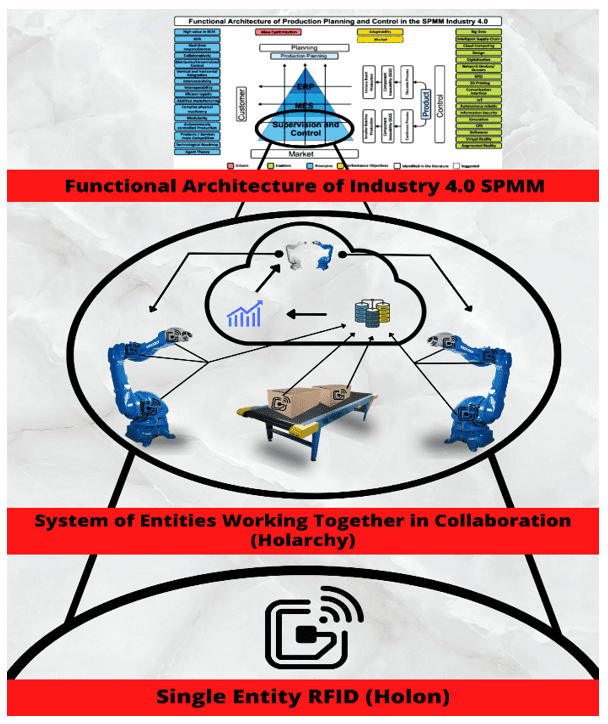
4.2 WHICH CAPABILITIES ARE ACQUIRED, AND BARRIERS ARE FACED TO MOVE INDUSTRY 4.0 TOWARDS A NEW HMS?
Through a systematic literature review, we raised capabilities and barriers that impact Industry 4.0. Each capability allows organisations to perform a physical or non-physical task related to the category of autonomy it affects.
Regarding Barriers, each one impacts one of the three SIPs’ levels of autonomy. To achieve level 1, for example, organisations must first surpass all the barriers that impact level 0. Level 0 in our conceptual deduction framework is any paradigm currently used by an organisation at the moment to start the transition towards the Industry 4.0 Paradigm. Table 1 presents the capabilities and the level each one is associated. Table 2 shows the barriers identified in the literature and the respective levels of each impact.
4.3 WHAT IS THE ROLE OF SIPS IN ALLOWING THE EVOLUTION OF INDUSTRY 4.0 FROM A SPMM TOWARD A NEW HMS? AT WHICH MOMENT INDUSTRY 4.0 BECOMES A NEW HMS?
The capabilities identified in the literature allow operations to acquire smartness according to three levels. This section presents features of traditional HMS and New HMS, seeking to identify the difference between them and the SIP’s role in operationalising New HMS through capabilities provided for operations. Table 3 summarises the features of traditional and New HMS.
Based on the comparison presented in the table and the previous steps followed, we propose a conceptual deduction framework that describes the relationship between capabilities, barriers, SIPs complexities level and enablers, that allow a manufacturing system to advance from any paradigm (traditional level) to Industry 4.0 SPMM (Levels connected and Transparent) and, in their limit, to a New Holonic Manufacturing System (Autonomous Decision-Making Level).
This way, the presented framework illustrates the path followed by a production system to evaluate from a traditional paradigm (mass manufacturing, lean manufacturing, responsive manufacturing e etc.) first to Industry 4.0 as a paradigm and after a complete maturity of the entire system, to Industry 4.0 as a New HMS.
Fig. 2. Industry 4.0 evolutional path towards New HMS
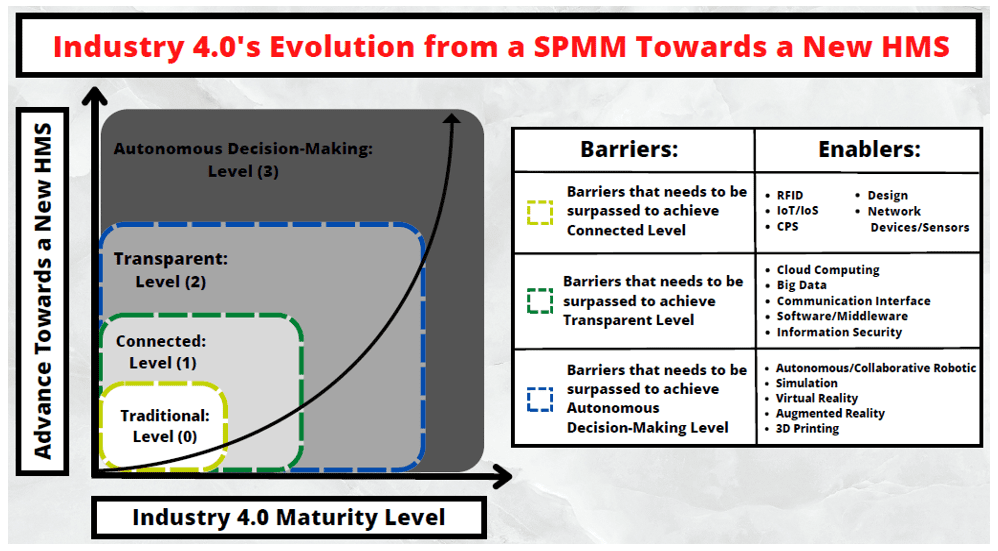
5. DISCUSSIONS
Our work presented the relationship between the functional Architecture of Industry 4.0 SPMM and SIPs. This relationship, aligned with SIP’s concept, considers a SIP as a path to operationalise Industry 4.0 (in its first levels of adoption).
Table 1. Capabilities provided by SIPs’ adoption for organisations
| Capabilities | Level/Functions Impacted |
| Improved efficiency in terms of asset investment | 1) AM |
| The process becomes more sustainable | 2) SUS |
| Improvement in maintenance accuracy by viewing, drawing, and designing data | 2) MM/ PPC |
| Remote repair services | 2) MM |
| Collecting and carrying information about itself during its lifecycle | 1) MM |
| Integration of sensing technologies into passive RFID tags | 2) PPC |
| Interoperability among autonomous intelligent resources inside/outside the organisation | 2) PPC |
| Automatic reconfiguration of the SIPs | 3) PPC |
| Dynamic reconfiguring of the team’s resources | 2) PPC |
| Integration among physical, cyber, and social environments with high autonomy level | 3) PPC |
| Remote process control | 2) PPC |
| Optimising a product’s performance through the reuse of experiences to enhance its decisional performance | 2) PPC |
| Machines linking together in systems | 1) PPC |
| Data collection capability is improved | 1) PPC |
| More robust and flexible production systems | 3) PPC |
| Better complexity management associated with the combined offer of products and services within organisational units | 3) PPC |
| Improvement of products’ performance | 3) PPC/ QM |
| Increased visibility of ongoing operations | 2) PPC/ QM |
| High-value aggregation | 3) QM |
| Ongoing quality management | 2) QM |
| High process security | 2) QM |
Source: Author, 2023.
Table 2. Barriers faced by organisations to fully deploy Industry 4.0
| Barriers | Level Impacted |
| Communication difficulties | 1 |
| Vulnerability in data security | 1 |
| Decreased planning efficiency when control is decentralised | 2 |
| Difficulties in integrating many different SIP | 2 |
| Difficulties in aligning old industrial technologies with the implementation of a new SIP | 1 |
| Lack of technological maturity | 0 |
| Full adoption difficulties and lack of system stability (operational practicality and decision execution) | 0 |
| Contractual and revenue-sharing challenges | 1 |
| Social, psychological, and cultural individualistic behaviour barriers | 0 |
| Lack of technical and economic feasibility in the early stage of utilisation | 0 |
| Complicated system introduction or even its affinity with already existing business systems | 1 |
| Tracking technology remains a fundamental challenge in transforming the abundance of operational information into accurate and timely control decisions | 2 |
| Lack of infrastructure (network and network latency) in some regions of the country where industries are based | 0 |
| Uncertainty about ROI, payback, high costs and investments to (internally) develop a SIP | 0 |
| Self-adaptation difficulties among the SIP and its environment (plug-and-play technologies) | 1 |
| High energy consumption | 2 |
| Risk of lousy event propagation | 2 |
| High complexity of Management | 2 |
| Lack of security and trust in using data | 2 |
| High complexity of system management due to the increase in the number of agents used | 2 |
| Cost strategy is not adherent to innovative SIP solutions | 0 |
| Cyber-attack vulnerability | 2 |
| Lack of adequate computational resources | 0 |
Source: Author, 2023.
Table 3. Comparison between traditional and New HMS
| Traditional HMS | New HMS |
| HMS as PPC Systems that realise tasks required to ensure a fully functional manufacturing operation (Mcfarlane; Bussmann, 2010) | New HMS as an holarchy is composed of organisational functions, integrating ERP to feed the system with information/recommendations subsidising long-term decision-making |
| An integrated methodology for the development of distributed manufacturing operations supporting local decision-making (Mcfarlane; Bussmann, 2010) | Origins based on the main disruptive technologies such as Big Data, Analytics, Digital Twin, Edge Computing, Cloud Computing, and other disruptive technologies |
| Loose hierarchies to allow global optimisation (BRUSSEL et al., 1998, 1999) | Hierarchy loss continues to be a premise in the physical parts of New HMS. However, a nonphysical part, unique for all individual holons, will support more accurate decision-making |
| New events’ reaction (Cardin et al., [s.d.]) | New events reaction is the base to support new behaviours proposal, adapting the system to respond and prepare itself for new occurrences and disturbances based on historical data |
| Myopia of local decision agents (Cardin et al., [s.d.]) | The historical period of data collected and used is adjusted to provide the best solution |
| Holarchy integrates a complete range of manufacturing activities forming agile manufacturing (Cardin et al., [s.d.]) | Big Data and Analytics, together with other disruptive technologies, allow a more precise reaction, however, with a higher period of inertia. |
| Development of flexible and adaptative systems for manufacturing, equivalent to “plug and Play” technologies of new computational systems (HMS, 1999) | A new generation of (intelligent) manufacturing systems will effectively form, virtual reconfigurable factories, machines and softwares actuating in virtual groups, dynamically formed. Such systems will create reconfigurable, extensive and graded systems (Van Leeuwen; NORRIE, 1997) |
| Performance warranty achieved through individual /group of holon self-exclusion of the system (Cardin et al., [s.d.]) | Maintenance achieved on distance, based on historical data, spare parts is acquired in the exact moment of the disturbance less the estimated acquisition lead time |
Source: Author, 2023.
In the following, we present the SIP’s role in evaluating Industry 4.0 from a SPMM to a New HMS. It was shown that three different groups of capabilities are provided for organisations according to the maturity level of a SIP.
Organisations must surpass all the structural barriers to evaluate from the traditional level to the next. These barriers do not allow evolution from one level (e. g. Connected (Level 1), Transparent (Level 2) and Autonomous Decision-Making (Level 3)) to the next until all of them be surpassed. Thus, to illustrate the relationship between all the variables and concepts presented in this research, a conceptual deduction framework was introduced.
Concerning theoretical contributions, this research presented a conceptual-deduction framework to illustrate the evolution of a traditional SPMM towards a New HMS. The conceptual deduction framework may help researchers of both research fields to join research efforts toward the same final objective, achieve New HMS.
Regarding practical contributions, the framework presented gives managers in practice a deep understanding of the pathway from a traditional paradigm to a New HMS. The framework presented allows managers to readily identify which capabilities will be acquired and which barriers should be surpassed before achieving a new group of capabilities.
6. CONCLUSIONS
The reviewed literature revealed the role of SIP in operationalising New HMS in organisational environments. A systematic literature review was conducted to identify the barriers and capabilities, papers addressing features and objectives of traditional HMS were also raised to support the conceptual deduction framework.
The contribution of this study is related to the structured framework presented, which makes it possible to conclude that, in the limit of its full adoption (achievement of Level 3), Industry 4.0 becomes a New HMS. This conclusion may do researchers from both fields to joint efforts, collaborating to faster achieve New HMS, bringing a new era for manufacturing systems and, why not, for organisations as a whole. As a limitation, this study didn’t consider the human factor and its role in achieving Industry 4.0 as a New HMS. Therefore, future research should focus on exploiting human-related factors, such as the role of managers and workers in influencing the adoption and implementation of Industry 4.0, to make possible identifying best practices and strategies for the successful achievement of New HMS.
REFERENCES
BRUSSEL, H. VAN et al. Reference architecture for holonic manufacturing systems : PROSA. 1998.
BRUSSEL, H. VAN et al. A Conceptual Framework for Holonic Manufacturing : Identification of Manufac ring Holons. v. 18, n. 1, p. 35–52, 1999.
CARDIN, O. et al. Evolution of holonic control architectures towards Industry 4.0: A short overview. IFAC-PapersOnLine, v. 51, n. 11, p. 1243–1248, [s.d.].
CHRISTENSEN, J. H. Holonic Manufacturing System: Initial architecture and standards directions. Presented at First European Conference on Holonic Manufacturing Systems, Hannover, Germany, 1 December 1994. n. March, p. 1–20, 1994.
FRANCO, G. N.; BATOCCHÍO, A. Sistemas holônicos de manufatura : revisando. n. 1997, p. 8–10, 1999.
GODINHO FILHO, M. Paradigmas estratégicos de gestão da manufatura: configuração, relações com o planejamento e controle da produção e estudo exploratório na indústria de. [s.l: s.n.]. 2004.
HMS. Welcome to the Holonic Manufacturing System (HMS) web site. 1999.
IBM. How Industry 4.0 Technologies are Changing Manufacturing. [s.d.]
KAGERMANN, H.; WAHLSTER, W.; HELBIG, J. Recommendations for Implementing the Strategic Initiative Industrie 4.0. Proceedings of the 2019 20th International Conference on Research and Education in Mechatronics, REM 2019. Anais…2013.
LIN, N. Foundations of Social research. Third ed. [s.l.] McGraw-Hill, 1976.
MCFARLANE, D. C.; BUSSMANN, S. Developments in holonic production planning and control. Production Planning & Control, v. 7287, n. 11:6, p. 522–536, 2010.
MEREDITH, J. Theory Building through Conceptual Methods. International Journal of Operations & Production Management, v. 13, n. 5, p. 3–11, 1993.
OLUYISOLA, O. E.; SGARBOSSA, F.; STRANDHAGEN, J. O. Smart production planning and control: Concept, use-cases and sustainability implications. Sustainability (Switzerland), v. 12, n. 9, 2020.
PISSARDINI, P. E. et al. RFID and Industry 4.0: The Technology’s Role on Shop Floor Control Operationalisation. International Journal of Innovations And Sustainability, v. 13, p. 174–185, 2022.
PISSARDINI, P. E.; CALLEFI, M. H. B. M.; GODINHO FILHO, M. Capabilidades dos Smart Industrial Products: Uma Revisão Sistemática de Literatura. 2021.
PISSARDINI, P. E.; SACOMANO, J. B. O Planejamento E Controle Da Produção Na Indústria 4.0 E Seu Alinhamento Com Os Paradigmas Estratégicos De Gestão Da Manufatura. Engenharia de Produção: What’s Your Plan? 2, n. 2004, p. 443–456, 2019a.
PISSARDINI, P. E.; SACOMANO, J. B. Sistema de Coordenação de Ordens para a Indústria 4.0: Proposta de uma Arquitetura para implantação. “Os desafios da engenharia de produção para uma gestão inovadora da Logística e Operações. Anais…2019b.
VAN LEEUWEN, E. H.; NORRIE, D. Holons and holarchies. Manufacturing Engineer, v. 76, n. 2, p. 86–88, 1997.
[1] PhD student in the Postgraduate Program in Production Engineering at the Federal University of São Carlos, Master in Production Engineering, Specialist in Production Engineering, Bachelor in Mechanical Production Engineering. ORCID: 0000-0002-2179-1572. Currículo Lattes: https://lattes.cnpq.br/4570604108944635.
[2] Graduating in Production Engineering. ORCID: 0000-0001-5790-640X.
Posted: August 30, 2023.
Approved: September 6, 2023.


